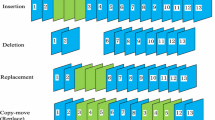Abstract
Blue screen compositing is one of the most common methods to do video forgery. However, few algorithms have been proposed to detect the forgery in this form. This paper presents a 3-stage Foreground Analysis and Tracking algorithm (3FAT) to detect blue screen compositing. The 3FAT algorithm contains three major stages: foreground block extraction, forged block detection and forged block tracking. The first stage extracts the foreground blocks by a multi-pass foreground locating method. In the second stage, a feature-comparison level fusion of local features consisting of luminance and contrast is put forward to seek out the tampered foreground block. In the last stage, a fast target search algorithm based on Compressive Tracking is used to track the tampered block of subsequent frames. Compared with previous algorithm, 3FAT can not only rule out the distractions of noise and other moving foregrounds, but also be applied to any video format, bit rate and encoding mechanism. The experiments show that the 3FAT algorithm has higher accuracy and performs well in terms of speed.












Similar content being viewed by others
References
Bagiwa MA, Wahab AWA et al (2016) Chroma key background detection for digital video using statistical correlation of blurring artifact. Digit Investig 19:29–43
Bidokhti A, Ghaemmaghami S (2015) Detection of regional copy/move forgery in MPEG videos using optical flow. Artificial Intelligence and Signal Processing (AISP), 2015 International Symposium on
Candes EJ, Tao T (2006) Near optimal signal recovery from random projections: universal encoding strategies. IEEE Trans Inf Theory 52(12):5406–5425
Chen W, Yang G, Chen R, Zhu N (2011) Digital video passive forensics for its authenticity and source. J Commun 32(6):77–182
GB Chittapur et al (2014) Exposing digital forgery in video by mean frame comparison techniques. Emerging Research in Electronics, Computer Science and Technology. Springer India, 557–562
D’Amiano L et al, (2015) Video forgery detection and localization based on 3D patchmatch. Multimedia & Expo Workshops (ICMEW), 2015 I.E. International Conference on. IEEE
Diaconis P, Freedman D (1984) Asymptotics of graphical projection pursuit. Ann Stat:793–815
Dibyendu M (2013) Multiresolution based Gaussian mixture model for background suppression. IEEE Trans Image Process 22(12):5022–5035
Felzenszwalb PF, Huttenlocher DP (2004) Efficient Graph-based image segmentation. Int J Comput Vis 59(2):167–181
Jordan A (2002) On discriminative vs. generative classifiers: a comparison of logistic regression and naive bayes. Adv Neural Inf Proces Syst 14(1):841
Kobayashi M, Okabe T, Sato Y (2009) Detecting video forgeries based on noise characteristics, Advances in Image and Video Technology. Springer, 306–317
Li F, Huang T (2013) Video copy-move forgery detection and localization based on structural similarity. In: Farag A, Yang J, Jiao F (eds) Proceedings of the 3rd International Conference on Multimedia Technology (ICMT 2013). Lecture Notes in Electrical Engineering, Springer, Berlin, Heidelberg, vol 278, pp. 63–76
Otsu N (1979) A threshold selection method from gray level histogram. IEEE Trans Syst Man Cybern 9(1):62–66
Porter T, Duff T (1984) Compositing digital images, Computer Graphics Proceedings, Annual Conference Series. ACM SIG-GRAPH, New York: 253–259
Shujia Y, Lijun J, Shaohui D, Ling Z, Chunyu Y, Wenhao Z (2012) Power line image segmentation and extra matter recognition based on improved Otsu algorithm. IET Image Process 6(4):426–433
Smith AR, Blinn JF (1996) Blue screen matting. Computer Graphics and Interactive Techniques:259–268
Stauffer C, Grimson W (1999) Adaptive background mixture models for real-time tracking, 1999 I.E. computer society Conference on computer vision and. Pattern Recogn 2(3):246–252
Su Y, Han Y, Zhang C (2011) Detection of blue screen based on Edge Features, Information Technology and Artificial Intelligence Conference (ITAIC), 2011 6th IEEE Joint International. 469–472
Subramanyam AV, Emmanuel S (2012) Video forgery detection using HOG features and compression properties, 2012 I.E. 14th International Workshop on Multimedia Signal Processing (MMSP). 89–94
Vincent L (1994) Fast opening functions and morphological granulometries, Conference on Image Algebra and Morphological Image Processing. 253–267
Wang W, Farid H (2006) Exposing digital forgeries in video by detecting double MPEG compression, Proceedings of the 8th workshop on Multimedia and security. ACM 37–47
Wang W, Farid H (2007) Exposing digital forgeries in interlaced and deinterlaced video. IEEE Transactions on Information Forensics and Security 2(3):438–449
Wang W, Farid H (2007) Exposing digital forgeries in video by detecting duplication, Proceedings of the 9th workshop on Multimedia & security. ACM 35–42
Wang W, Farid H (2009) Exposing digital forgeries in video by detecting double quantization, Proceedings of the 11th ACM workshop on Multimedia and security. ACM 39–48
Wang Z, Bovik AC, Sheikh HR (2004) Image quality assessment: from error visibility to structural similarity. IEEE Trans Image Process 13(4):600–612
Wright J, Yang AY, Ganesh A, Sastry SS, Ma Y (2009) Robust face recognition via sparse representation. IEEE Trans Pattern Anal Mach Intell 31(2):210–227
Xu J, Yu Y, Su Y, Dong B, You X, Detection of Blue Screen Special Effects in Videos (2012) International Conference on medical physics and biomedical engineering. Phys Procedia 33:1316–1322
Zhang K, Zhang L (2012) Real-time compressive tracking. Computer Vision - ECCV 2012:864–877
Zhang J, Su Y, Zhang M (2009) Exposing digital video forgery by ghost shadow artifact, Proceedings of the First ACM workshop on Multimedia in forensics. ACM 49–54
Zhou L, Wang D (2008) Digital image forensics. Beijing University of Posts and Telecommunications Press, Beijing, pp 8–13
Author information
Authors and Affiliations
Corresponding author
Ethics declarations
Financial support
National Natural Science Foundation of China (Grant No. 61070062). The Hundreds of Young Teachers of Climbing Project of Longyan University (Grant No. LQ2016005, LQ2015031).
Rights and permissions
About this article
Cite this article
Liu, Y., Huang, T. & Liu, Y. A novel video forgery detection algorithm for blue screen compositing based on 3-stage foreground analysis and tracking. Multimed Tools Appl 77, 7405–7427 (2018). https://doi.org/10.1007/s11042-017-4652-7
Received:
Revised:
Accepted:
Published:
Issue Date:
DOI: https://doi.org/10.1007/s11042-017-4652-7




